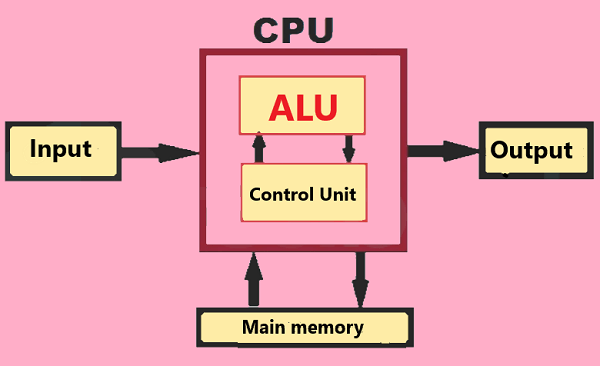What is the full form of ALUALU: Arithmetic Logic UnitALU stands for Arithmetic Logic Unit. It is a combinational digital circuit which does arithmetic and bitwise operations on integer binary numbers. It is one of the main components of the computer's Central Processing Unit (CPU) that is designed to perform arithmetic and logical tasks. 
The ALU results in an integer as it not only performs the calculations concerned with subtraction and addition but also calculates the multiplication of two integers as they are designed to execute integer calculations. Hence, resulting in an integer. Signals are received from the external circuits by the Arithmetic Logic Unit input, and external electronics get outputs signals from ALU as its response. SignalsAn Arithmetic Logic Unit possesses a variety of input and output nets. The nets or signals are nothing other than what are used to convey digital signals between the Arithmetic Logic Unit and external circuitry, i.e. electrical conductors. External circuits add signals to the Arithmetic Logic Unit when an Arithmetic Logic Unit is operating. In response to these signals sent, the Arithmetic Logic Unit then produces and conveys signals via its outputs to the external circuitry.
Circuit OperationA simple four-bit Arithmetic Logic Unit is the combinational logic circuitry. It is part of the 74181 integrated circuits. An asynchronous change will occur in an Arithmetic Logic Unit as a response to the input changes, as it is a combinational logic circuit. Stable signals are included in the ALU inputs in normal operation. FunctionsCommonly Arithmetic Logic Unit supports numerous bitwise logic and basic arithmetic functions. These operations are typically included in basic general-purpose ALUs
ApplicationsThe application of the Arithmetic Logic Unit is as follows:-
HistoryMathematician John von Neumann was the one who, in 1945, proposed the concept of the Arithmetic Logic Unit. It was contained in a report produced on the foundations for a new computer called the EDVAC. It was in the early 1970s that microprocessors began to appear. Often insufficient die space for a full-word-width ALU, despite smaller transistors, was present. Examples include the popular Zilog Z80, which has performed the eight-bit additions with a four-bit Arithmetic Logic Unit. Advantages of ALUArithmetic Logic Unit has various advantages, which are as follows:
Disadvantages of ALUThe disadvantages of the Arithmetic Logic Unit are discussed below:
Next TopicFull Form
|
 For Videos Join Our Youtube Channel: Join Now
For Videos Join Our Youtube Channel: Join Now
Feedback
- Send your Feedback to [email protected]
Help Others, Please Share










